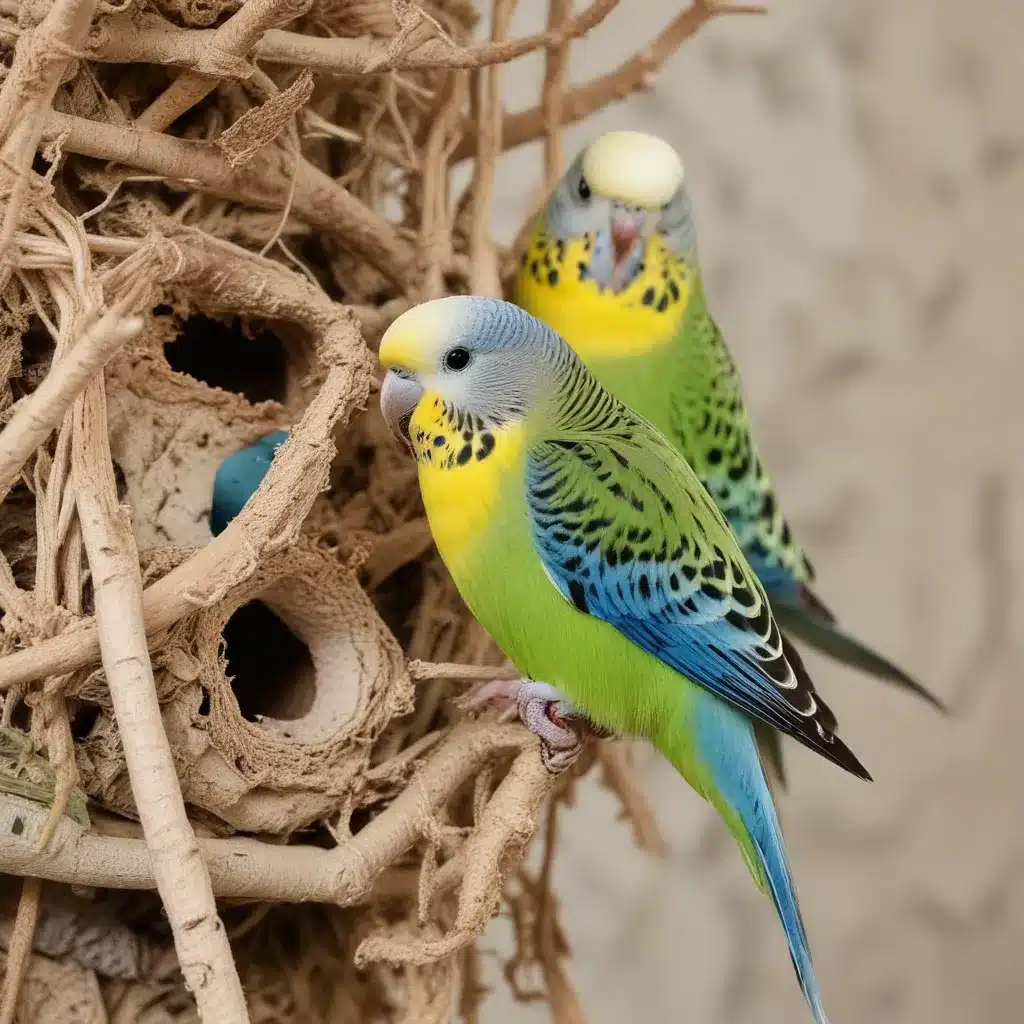
Budgie Builders: Encouraging Nesting Behaviors in Your Parakeet Flock
As an experienced avian caretaker, I’ve had the pleasure of observing and caring for countless budgies (also known as parakeets) over the years. These charismatic little birds are not only visually stunning with their vibrant colors, but they also possess a rich repertoire of fascinating behaviors – none more captivating than their natural nesting instincts.
Budgie Biology and Characteristics
Budgies are members of the parrot family, and like their larger cousins, they are biologically wired to seek out secure, enclosed spaces for nesting and breeding. In the wild, budgies would typically nest in tree cavities or other sheltered areas, constructing a cozy abode using a variety of materials.
Their slender, agile bodies and sharp beaks make them well-suited for this task. Budgies have excellent foot dexterity, allowing them to manipulate nesting materials with precision. Their keen eyesight and problem-solving abilities also aid in locating and accessing suitable nesting sites.
Behaviorally, budgies are highly social creatures, living in large flocks in their native Australian habitats. This social nature translates to the home environment, where budgies form strong bonds with their human caretakers and fellow flock members. Nurturing these bonds is key to fostering healthy nesting behaviors.
Nesting Requirements for Budgies
When it comes to nesting, budgies have very specific requirements. In the wild, they seek out sheltered, dark cavities that provide a sense of security and privacy. This could be a tree hollow, a crevice in a rock face, or even an abandoned nest of another bird species.
The materials they use for nest construction are equally important. Budgies will gather a variety of natural fibers, such as grass, leaves, and twigs, to create a soft, insulating base for their eggs and chicks. They may also incorporate feathers, moss, and even human-made materials like cotton or paper.
Preparing the Aviary Environment
When keeping budgies in captivity, it’s crucial to recreate these nesting conditions as closely as possible. Start by providing suitable nesting spots within the aviary or cage. This could be a purpose-built nestbox, a cozy corner with plenty of cover, or even a suspended platform. Ensure that the area is dimly lit and secluded, allowing your budgies to feel safe and undisturbed.
Next, introduce a variety of nesting materials. Offer a selection of natural fibers, such as untreated cotton, shredded paper, or small twigs. Avoid using anything with sharp edges or potentially toxic components. Encourage your budgies to explore and incorporate these materials into their preferred nesting spot.
Monitoring Nesting Activities
Once your budgies have established their nesting area, observe their behavior closely. Watch for signs of pair bonding, such as mutual preening, billing and cooing, or even courtship displays. As the breeding season approaches, you may witness the budgies actively constructing their nest, meticulously arranging the materials and shaping the structure.
It’s important to strike a delicate balance when monitoring your budgies’ nesting activities. While you’ll want to ensure their safety and well-being, avoid excessive interference or disturbance, as this can disrupt the natural breeding process and potentially lead to nest abandonment.
The Breeding Cycle
Budgies are prolific breeders, and their breeding cycle is closely tied to environmental cues such as photoperiod and temperature. As daylight hours increase and the weather warms, your budgies may begin to exhibit courtship behaviors, leading to the formation of breeding pairs.
Once paired, the budgies will work together to construct their nest and prepare for egg-laying. The female will typically lay a clutch of 4-6 eggs, which both parents will take turns incubating for around 18-21 days. After hatching, the chicks will remain in the nest, relying on their parents for food and care, for an additional 4-6 weeks before fledging.
Caring for Budgie Chicks
Observing the development of budgie chicks is a truly rewarding experience. As the nestlings grow, their feathers will gradually emerge, and their vocalizations will become more pronounced. Maintain a hands-off approach during this critical period, allowing the parents to carry out their natural parenting duties.
Provide the breeding pair with a nutritious diet, rich in proteins, vitamins, and minerals, to support the increased energy demands of chick-rearing. Additionally, ensure that the nesting area remains clean and free of any potential hazards.
Potential Nesting-Related Issues
While nesting is a natural and essential behavior for budgies, it’s not without its potential challenges. One common issue is egg binding, where a female budgie is unable to successfully lay an egg. This can be a life-threatening condition that requires immediate veterinary attention.
Maintaining proper nest hygiene is also crucial. Dirty or damp nesting materials can harbor harmful bacteria and parasites, potentially compromising the health of the chicks. Regular cleaning and replacement of soiled materials can help mitigate these risks.
Supporting Budgie Health During Nesting
To ensure the overall well-being of your budgies during the nesting season, focus on providing a balanced, nutrient-dense diet and a low-stress environment. Supplement their regular pellet or seed-based diet with fresh, high-quality fruits and vegetables to meet their increased nutritional needs.
Additionally, be mindful of potential stressors, such as loud noises, excessive handling, or changes to the aviary setup. Minimize disruptions and allow your budgies to carry out their nesting and breeding behaviors with minimal interference.
By understanding the unique nesting requirements of budgies and creating a supportive environment, you can encourage healthy, successful breeding within your flock. Observing the intricate dance of courtship, nest-building, and chick-rearing is a truly rewarding experience for any avian enthusiast.
Remember, the team at Mika Birds Farm is always here to provide guidance and support on all aspects of budgie care, from habitat setup to health management. Let us know if you have any additional questions or need further assistance in fostering a thriving budgie flock.


